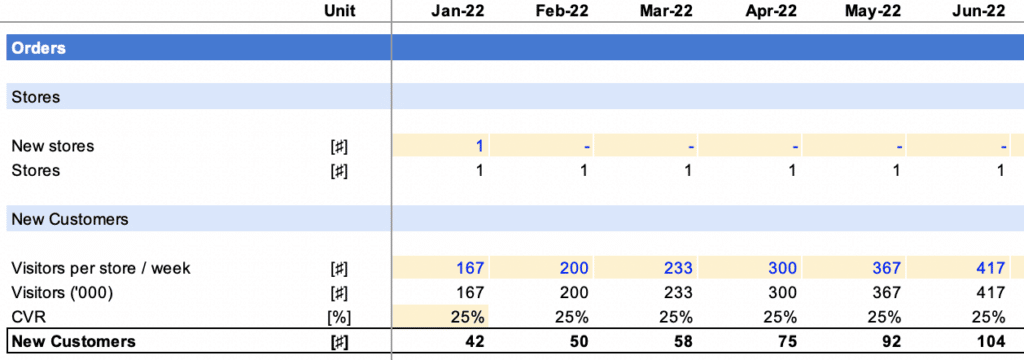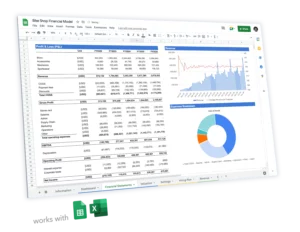How To Build a Financial Model For a Bike Shop

Every business needs a budget. Whether you want to understand what’s your breakeven, your valuation or create a financial model for your bike shop business plan, you’ve come the right way.
Whether you sell bikes, sportswear or accessories, in this article we’ll explain you how to create powerful and accurate financial projections for a bike shop business.
For more information on bike shop businesses, make sure to read our guide below: How to Write a Bike Shop Business Plan: Complete Guide How to Open a Bike Shop Business in 9 Steps? How Much Does It Cost To Open a Bike Shop? Examples
1. Forecast customers & transactions
The first thing you need to do is to estimate the number of customers you will acquire, and retain, over time.
The number of customers who make a purchase each month is the result of:
Customers = New customers + Repeat customers
New Customers
New customers are a function of the visitors that enter your store, and a conversion rate. For example: 400 visitors per week x 30% = 120 transactions a week.

Repeat Customers
There are multiple ways to do this.
The most accurate (and flexible) is to set a number of assumptions:
- The percentage of your customers who are repeat (those who will buy 2 or more times in their lifetime from your store)
- The purchase frequency (when they buy again, how many times a year do they do so?)
- The churn rate (they will likely not buy forever, instead they might churn in average after 10 years or so)
This will allow you to accurately forecast the transactions made by repeat customers in the future and obtain something like the chart below.
Note that in this example, repeat customers represent 75% of total customers. Also, they come back multiple times a year, which explains why the number of transactions from repeat customers grows far more than new customers orders.

2. Forecast revenue
Once you have estimated the number of transactions, both from new and repeat customers, you can calculate revenue.
Before we jump into revenue, we recommend to use a pricing table with, for each product category:
- The unit selling price (per product)
- Sales mix percentage (how many customers do purchase this item?)
- Launch and end dates (if you discontinue the product line in the future for example)

You can now obtain your revenue projections as well as important metrics such as the average revenue per customer as shown below:

3. Forecast expenses
In addition to the one-off startup costs discussed here, we must forecast the recurring expenses to run a bike shop.
We have laid out below an example of how much it would cost to run a small bike shop with 3 full-time employees, as well as the main expenses categories discussed below.
Note: please note the amounts are for illustrative purposes only.
| Operating cost | Amount (per month) |
|---|---|
| COGS | $25,200 |
| Rent | $3,000 |
| Staff | $12,000 |
| Utility bills | $750 |
| Marketing | $1,200 |
| Insurance, software & other | $1,000 |
| Total | $43,150 |
COGS
COGS (Cost of Goods Sold) are the costs incurred to source the products you sell. For example, if you operate a bike shop that sells bikes, COGS are your costs to purchase the bikes from wholesalers and/or manufacturers.
The National Bicycle Dealers Association’s (NBDA) reported that the following gross profit margins:
- Bikes: 36%
- Clothing: 43%
- Other goods: 49.7%
This means that, assuming you only sell bikes, you should expect to spend on average 64% of your revenues in COGS. For example, if you sell a bike to a customer for $1,000, you should spend on average $640 to get it from the supplier, realising a profit margin of 36%.
So, assuming your monthly revenue is $40,000, COGS should be around $25,200.
Rent
If you use a leased space to run your bike shop business, be ready to pay a monthly rent. Again, this is never a constant figure, with many factors such as location, the lease of purchase, and space influencing the total amount payable.
In Chicago for example, the average rent for a commercial space is about $19.5 per square foot. This translates to about $3,000 per month if you operate a 2,000 sq. foot bike shop in this region.
Staff
Are you handling everything yourself or keen to include a few employees to help with managing the business? That’s a question best answered after assessing the size of the shop and your preferences.
You can employ one or two individuals to handle the sales part of the business and one expert in bike repair to help with frequent maintenance.
On average, a bike mechanic earns $35,000 per year in the US. So, assuming you have 3 bike mechanic full time employees, you will need about $12,000 to cover monthly salaries (including taxes and benefits).

4. Build your P&L And Cash flow
Once we have forecasted revenues and expenses, we can easily build the profit-and-loss (P&L) from revenues down to net profit.
This will help you to visualise key financial metrics such as Gross Profit or EBITDA margin as shown below:

The cash flow statement, in comparison, needs to include all cash items from the P&L and other cash movements such as capital investments (also referred as “Capex”), fundraising, debt, etc.
Cash flow is vital as it will help you understand how much funding you should get, either from investors or the bank (SBA loan for example) to start and run your own bike shop.
In the chart below, we’re showing you an example of what a typical cost structure a bike shop would have. Unsurprisingly, COGS and salaries represent ~70% of total expenses.




